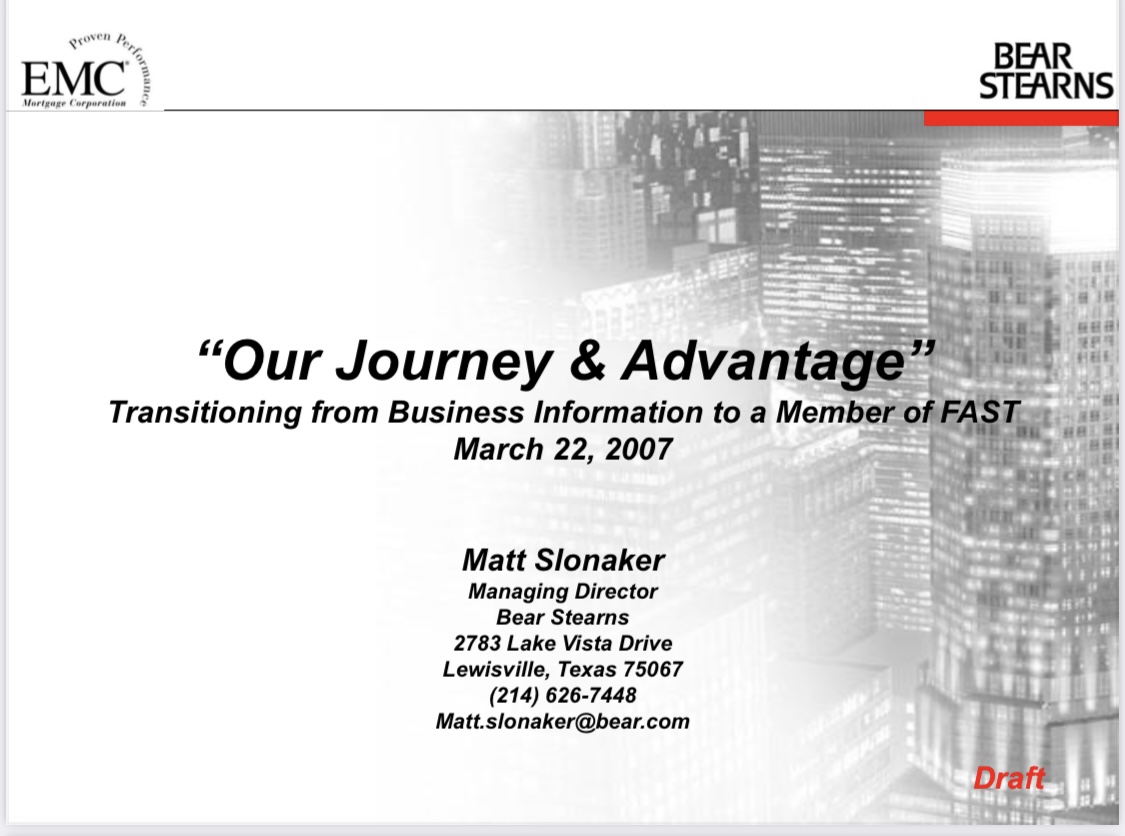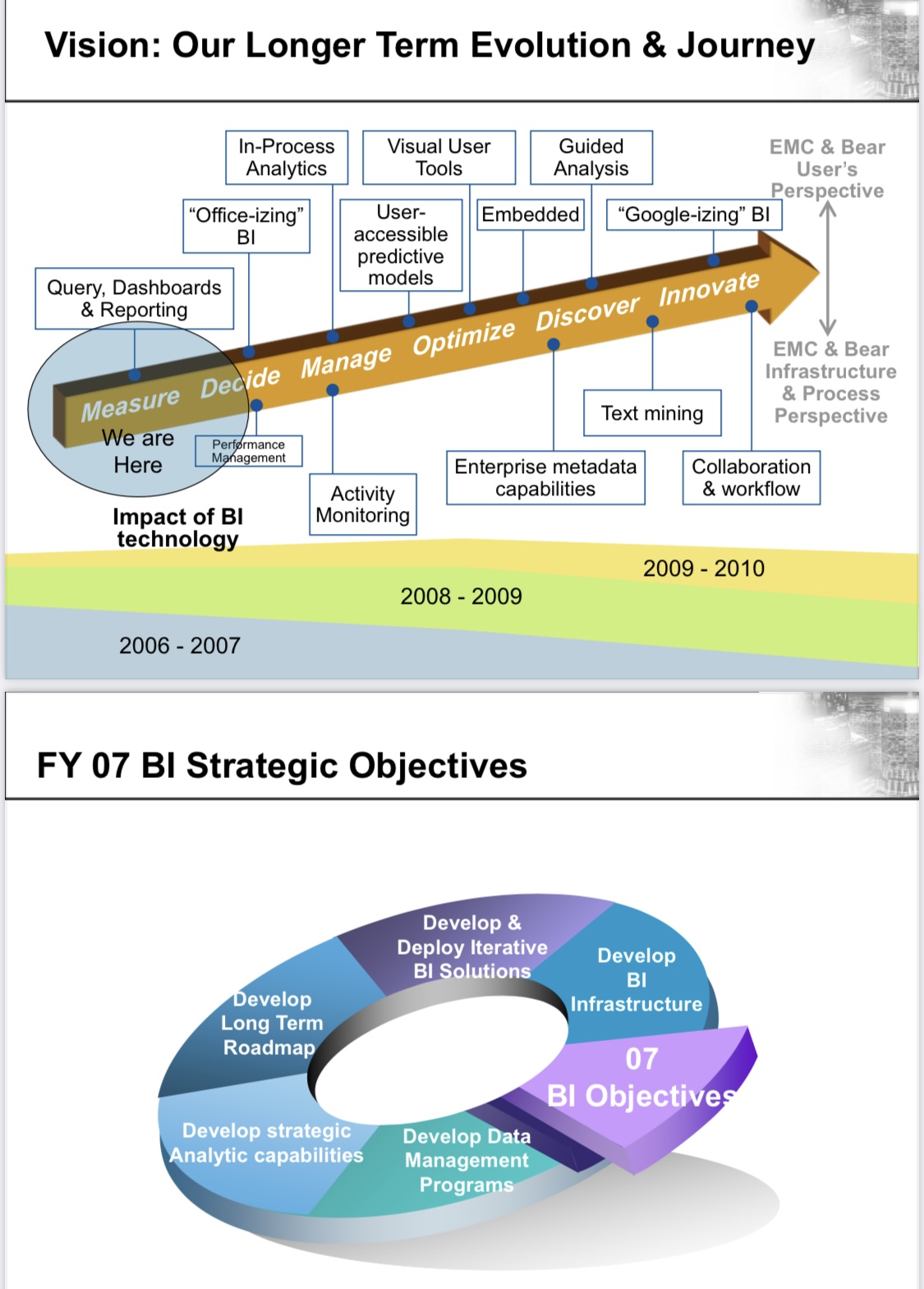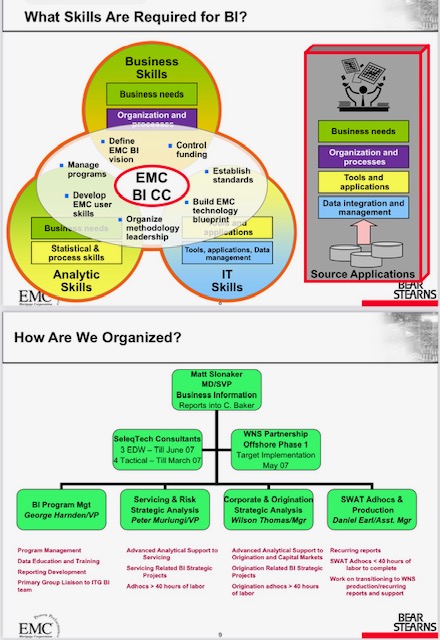Transforming the Business Information Division at EMC/Bear Stearns – Then and Now
Feb 25, 2025
As the Managing Director of the Business Information (BI) division at EMC/Bear Stearns, I led a transformative initiative in 2007, transitioning our team into a key member of the FAST (Fixed Income Analytical Structured Transaction) initiative. Below, I’ll outline the original plan and key aspects from that 2007 document, followed by how I would adapt and execute this strategy today in 2025, leveraging modern BI technologies, talent strategies, and market dynamics for our stakeholders.

The 2007 Plan and Key Aspects
On March 22, 2007, we faced a challenging financial landscape marked by deteriorating loan performance, flat or declining origination volumes, economic pressures, thinning profit margins, regulatory scrutiny, intense competition, and talent retention challenges. Our BI division’s strategy was designed to address these issues and position Bear Stearns for long-term success. Here are the core components of our plan:
1. People: Building a High-Performing Team
- We focused on aligning our organization under FAST, recruiting and placing senior analyst talent, completing transfers to ITG (EDW Report Developers), integrating WNS Analytical Talent, and launching a formal training and development plan.
- The goal was to eliminate silos, fill senior staff gaps, and create a culture of innovation and accountability.
2. Products, Processes, and Services: Delivering Strategic Value
- We prioritized completing default risk models, advancing Pipeline Management Analytics (PMA) for seller/collateral risk, developing Net Present Value & Default Decision Support tools, and expanding services to align with BSRM, Retention, Encore, and Risk Management.
- Initiatives like the “Mod Squad” for operational monitoring aimed to enhance efficiency and decision-making.
3. Analytical Technology Integration & Deployment: Leveraging Innovation
- We configured the FAST sandbox environment in Dallas, leveraged Cognos for reporting and analytics, and integrated legacy BI products into the FAST web footprint.
- This technological backbone was critical to scaling our capabilities and meeting real-time data demands.
4. Current BI Landscape and Challenges
- Strengths included legacy data knowledge, C-level sponsorship, and early wins like the EDW foundation and Pipeline & Hedging Analytics.
- Weaknesses included immature BI platforms, an off-balance supply-and-demand model for talent, senior staff gaps, and internal funding issues for analyst silos delivering temporary solutions.
5. Why Focus on BI & Analytics?
- BI and analytics were positioned as strategic assets to model loan performance, forecast market shifts, manage risks, improve efficiency, ensure compliance, and maintain a competitive edge amid market pressures.
6. Deliverables and Vision
- We delivered the EDW foundation, BU Key Performance Metrics, Pipeline & Hedging Analytics, Predictive Intelligence Platform (MOM), Seller Scorecard, and over 200 ad hoc analyses monthly.
- Our vision was to evolve BI into a predictive, strategic hub driving Bear Stearns’ growth, with a financial plan allocating $5.8 million annually (excluding ITG costs) and addressing near-term issues like platform build, training, and data quality.


Executing the Plan Today in 2025
Fast-forward to 2025, the financial industry has evolved dramatically, but the core challenges—market volatility, regulatory pressures, competition, and talent dynamics—persist, albeit shaped by new technologies and economic realities. Here’s how I would adapt and execute this strategy today for our stakeholders, leveraging modern BI technologies, talent strategies, and market insights:
1. People: Building a Modern, Agile Workforce
- Talent Strategy: In 2025, I’d prioritize building a hybrid workforce combining in-house experts with remote, specialized talent accessed through global platforms like Upwork or LinkedIn. I’d focus on recruiting data scientists, AI specialists, and cloud architects to complement traditional analysts, addressing labor market challenges with flexible, remote-first hiring models.
- Training and Upskilling: Instead of a traditional training plan, I’d implement continuous learning programs using AI-driven platforms like Coursera or Udemy, focusing on skills in machine learning, generative AI, and cloud-based BI tools. I’d also foster a culture of cross-functional collaboration using virtual teams and agile methodologies to eliminate silos and enhance adaptability.
- Diversity and Retention: To address talent retention, I’d introduce competitive compensation packages, equity incentives, and wellness programs, while emphasizing diversity, equity, and inclusion to attract top-tier talent from underrepresented groups.
2. Products, Processes, and Services: Driving Data-Driven Innovation
- Advanced Analytics: Today, I’d expand beyond default risk models and PMA to incorporate real-time AI-driven predictive analytics, using machine learning to forecast loan performance, detect fraud, and optimize pricing in milliseconds. Tools like TensorFlow, PyTorch, or proprietary models could handle complex “what-if” scenarios and goal-seeking analyses.
- Integrated Platforms: I’d replace Cognos with modern BI platforms like Tableau, Power BI, or Looker, integrated with cloud ecosystems like AWS, Azure, or Google Cloud for scalability and real-time data processing. We’d develop Net Present Value and risk management tools using natural language processing (NLP) for intuitive decision support.
- Operational Efficiency: Using process mining tools like Celonis and robotic process automation (RPA), I’d enhance the “Mod Squad” concept into a real-time operational intelligence hub, monitoring and optimizing workflows across BSRM, Retention, Encore, and Risk Management with minimal human intervention.
- Regulatory Compliance: With increased regulatory scrutiny, I’d deploy AI-powered compliance monitoring systems to track FTC, SEC, and other regulatory requirements, ensuring proactive reporting and reducing legal risks.
3. Analytical Technology Integration & Deployment: Embracing Cutting-Edge Tools
- Cloud-Based BI: I’d abandon the FAST sandbox environment for a fully cloud-native architecture, leveraging AWS Redshift, Google BigQuery, or Azure Synapse for data warehousing and analytics. These platforms would enable scalable, secure, and cost-effective data processing, replacing legacy integrations with APIs and microservices.
- AI and Generative AI: I’d integrate generative AI tools like ChatGPT, Claude, or Grok for automated reporting, data storytelling, and stakeholder communication, enhancing accessibility and engagement. Predictive and prescriptive analytics would be powered by advanced algorithms, providing deeper insights into market risks and opportunities.
- Real-Time Dashboards: Instead of static web footprints, I’d develop interactive, real-time dashboards accessible via mobile and web, hosted on platforms like Datadog or Splunk, ensuring stakeholders have instant access to key metrics and alerts. Our delivery hub (e.g., www.emcbi.com) would become an AI-driven portal with chatbots for user support.
4. Addressing the 2025 BI Landscape
- Strengths: Our legacy data knowledge and executive sponsorship remain assets, now enhanced by decades of institutional learning and early adoption of cloud and AI technologies.
- Weaknesses: Platform immaturity is less of an issue today, but we’d face challenges integrating legacy systems with modern cloud architectures, managing data privacy under GDPR and CCPA, and combating AI bias in our models.
- Opportunities: The rise of fintech, blockchain for secure transactions, and quantum computing for complex modeling offers new avenues for innovation.
- Threats: Cybersecurity risks, talent poaching by tech giants, and economic uncertainty (e.g., post-pandemic recovery, inflation) could disrupt our plans. I’d mitigate these with robust security protocols, competitive talent strategies, and scenario planning.
5. Why Focus on BI & Analytics in 2025?
- The 2025 market is characterized by rapid digital transformation, AI-driven competition, and heightened customer expectations. BI and analytics are more critical than ever to model economic volatility, optimize loan portfolios, predict regulatory changes, and maintain profitability in a low-margin environment. We’d use BI to drive personalization for clients, enhance risk management with real-time fraud detection, and ensure compliance with evolving regulations through automated audits.
6. Financial and Operational Priorities for 2025
- Budget: I’d propose a budget of approximately $15–20 million annually, reflecting the higher costs of cloud infrastructure, AI tools, and talent acquisition. This would represent 3–5% of our cost-to-service target, adjusted for inflation and market growth, with investments in SaaS subscriptions, cybersecurity, and talent development.
- Key Issues: We’d focus on cloud migration risks, AI model validation, data governance, stakeholder training on new tools, and managing expectations around AI’s limitations (e.g., black-box models). I’d also prioritize building a diverse, agile team to handle rapid technological shifts.
7. Deliverables and Vision for 2025
- Current Deliverables: We’d deliver real-time EDW solutions on cloud platforms, AI-powered key performance metrics, predictive analytics for loan performance and market risks, and automated compliance reporting. Our Seller Scorecard would evolve into an AI-driven risk assessment tool, and we’d handle thousands of data requests monthly via generative AI chatbots.
- Vision: My vision for 2025 is to position BI as Bear Stearns’ AI-first analytics powerhouse, driving strategic decisions with real-time insights, predictive models, and personalized client solutions. We’d aim to be a market leader in fintech analytics, using blockchain for secure data sharing and quantum computing for complex risk modeling, ensuring Bear Stearns thrives in a digital-first economy.
Closing Thoughts for Stakeholders
In 2007, our BI transformation laid the foundation for Bear Stearns to navigate a challenging market. Today, in 2025, I’m confident we can build on that legacy, leveraging modern BI technologies, a dynamic talent strategy, and innovative processes to deliver unparalleled value. Our focus on people, products, and technology will ensure we remain competitive, compliant, and customer-centric in an era defined by AI, cloud computing, and economic uncertainty. I invite you to partner with us on this journey—visit our updated delivery hub (hypothetically, www.emcbi.com) or contact me directly to explore how we can drive your strategic goals forward. Together, we’ll shape the future of your company in a data-driven world.
